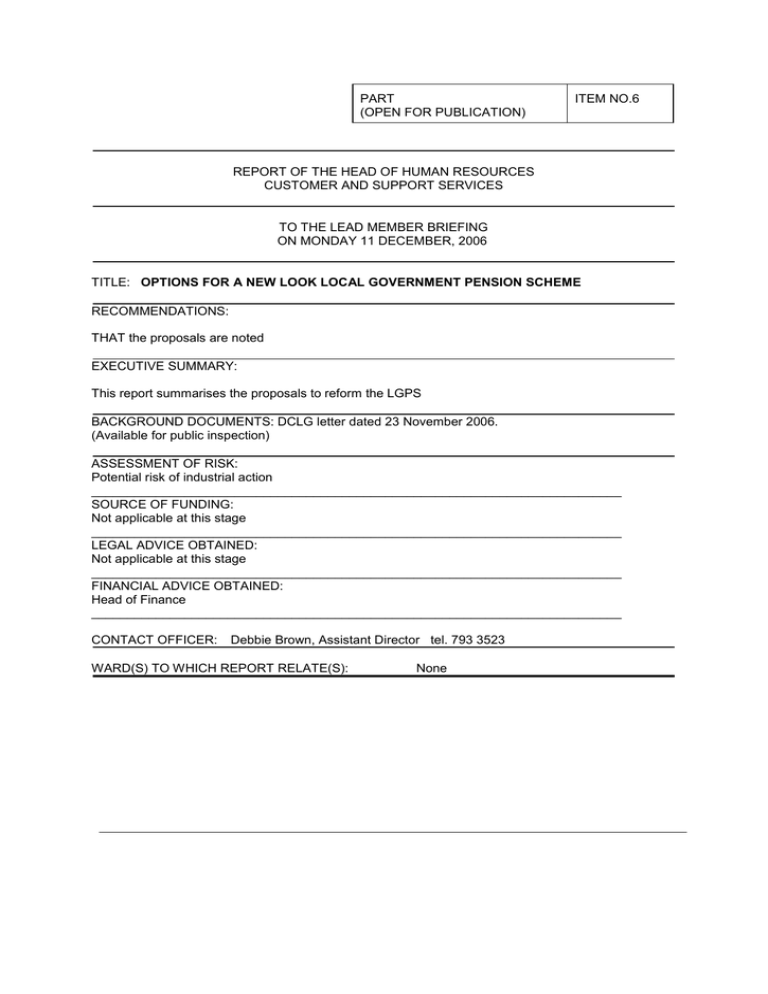PART ITEM NO.6 (OPEN FOR PUBLICATION)
advertisement

PART (OPEN FOR PUBLICATION) ITEM NO.6 REPORT OF THE HEAD OF HUMAN RESOURCES CUSTOMER AND SUPPORT SERVICES TO THE LEAD MEMBER BRIEFING ON MONDAY 11 DECEMBER, 2006 TITLE: OPTIONS FOR A NEW LOOK LOCAL GOVERNMENT PENSION SCHEME RECOMMENDATIONS: THAT the proposals are noted EXECUTIVE SUMMARY: This report summarises the proposals to reform the LGPS BACKGROUND DOCUMENTS: DCLG letter dated 23 November 2006. (Available for public inspection) ASSESSMENT OF RISK: Potential risk of industrial action __________________________________________________________________________ SOURCE OF FUNDING: Not applicable at this stage __________________________________________________________________________ LEGAL ADVICE OBTAINED: Not applicable at this stage __________________________________________________________________________ FINANCIAL ADVICE OBTAINED: Head of Finance __________________________________________________________________________ CONTACT OFFICER: Debbie Brown, Assistant Director tel. 793 3523 WARD(S) TO WHICH REPORT RELATE(S): None 1. INTRODUCTION 1.1 In a statement to Parliament on 23 November 2006, Phil Woolas, Minister for Local Government, set out reforms proposed for the Local Government Pension Scheme (LGPS) in England and Wales. This marks the start of a statutory consultation exercise to introduce a regulatory framework to provide a new look LGPS with effect from 1 April 2008. 2. OBJECTIVES FOR REFORM 2.1 The Government has undertaken to ensure that measures to reform the Scheme are affordable, viable and fair to the taxpayers who guarantee the Scheme’s statutory pension promise. Ministers have confirmed that it remains essential that the Scheme should also be as flexible and accessible as possible, for both employees and employers, so that it can provide a modern, equality-proofed range of defined benefits, both now and in the future. 2.2 It remains a significant objective also to achieve an equitable balance between the level of pension benefits provided by the scheme, and the actual cost of provision from all stakeholders’ points of view, including tax payers. 3. ELEMENTS OF THE NEW LOOK SCHEME 3.1 The following main elements being proposed are: final salary pension benefits to be based on 1/60th of salary for each year of pensionable service, with the flexible option to commute pension at the rate of £1 of annual pension for £12 of lump sump up to a maximum tax free lump sum of 25% of the capital value of accrued benefit rights at the date of retirement; a normal Pension Age (NPA) of 65 for release of unreduced benefits; earliest age for release of pension to be 55 by 2010 for current members, except on grounds of ill-health; earliest age for release of pension to be 55 for new joiners from 1 April 2008, except on grounds of ill health; augmentation of membership/benefits on an objectively justified basis; the better of the last year’s whole time equivalent salary or the ‘revalued (in line with the Retail Price Index (RPI)) average of the best three consecutive years’ salary in the last ten years of service; survivor benefits for life, payable to spouses, civil partners and “nominated” dependent partners (opposite and same sex) at a 1/160th accrual; survivor benefits payable to children at a maximum accrual of 1/160th; revised ill-health retirement package with no review system, to provide a higher level of benefits for total incapacity, and with different levels of benefits to recognise lesser incapacities; a death in service tax free lump sum of 3 times salary; scope for a post-retirement lump sum death benefit, up to a maximum of 10 years; phased retirement arrangements which would allow LGPS members, under specified circumstances, to draw down some, or all, of their accrued pension rights from the scheme while still continuing to work; tiered employee contribution rates with 5.5% payable on the first £12,000 of pensionable pay, and 7.5% to be paid on the excess over £12,000, estimated on current membership to produce an average rate of 6.3%; a facility for Scheme members to purchase up to a maximum £5,000 of additional annual pension; a facility for Scheme members to contribute towards their pension in conjunction with external AVC providers. 4. ILL HEALTH BENEFITS 4.1 There are three proposed elements to augmentation of membership where a member retires on ill-health: For those Scheme members judged to be unable to perform local government employment duties but able immediately to undertake gainful employment – accrued rights only; For those unable to undertake gainful employment on cessation, but likely to be able to do so before normal retirement age – accrued rights and augmentation of 25% of prospective service to normal retirement age; and For those unable to undertake gainful employment before normal retirement age – accrued rights and augmentation of 50% of prospective service to normal retirement age 5. PROTECTION ARRANGEMENTS FOR EXISTING SCHEME MEMBERS 5.1 Within the new-look LGPS benefits package, arrangements will be provided to protect fully the accrued rights for all existing Scheme members. The protection arrangements introduced following the removal of the rule of 85 will also continue to apply. 6. TRADE UNION RESPONSE 6.1 A recent Unison newsletter welcomes some positive proposals such as the retention of a final salary scheme based on a 1/60 accrual rate and some benefit improvements, they were disappointed that the Minister went ahead with the Statement despite being asked to wait until talks had been concluded. Unless the discussions are allowed to continue it looks highly likely that an industrial action ballot will take place. 6.2 Unison believe that the proposals are unacceptable for the following reasons: The employee contribution rate is increased for the majority of members from 6% to 7.5% The employer contribution rate is substantially reduced and effectively subsidised by the increased employee rate There is no additional protection for existing Scheme members to compensate for the loss of the rule of 85, despite far better arrangements being agreed in Scotland 7. CONCLUSION 7.1 The new look scheme is programmed to be fully operational from 1 April 2008 which requires the new regulations to be in place for 1 April 2007. 7.2 Further reports will be presented to inform Lead Member of developments.

